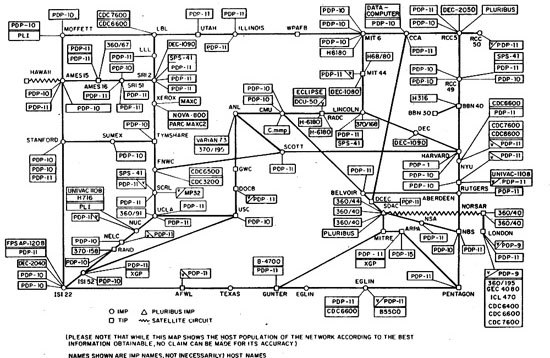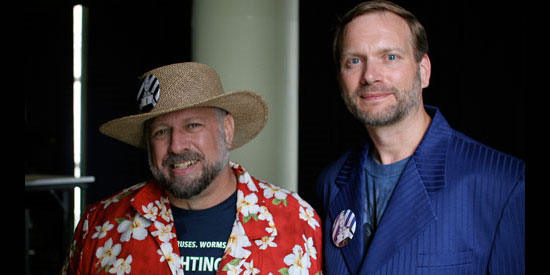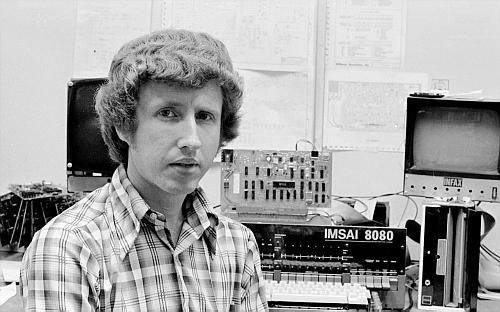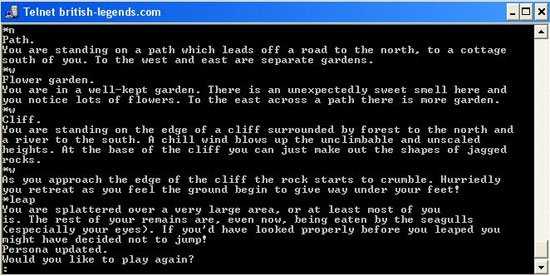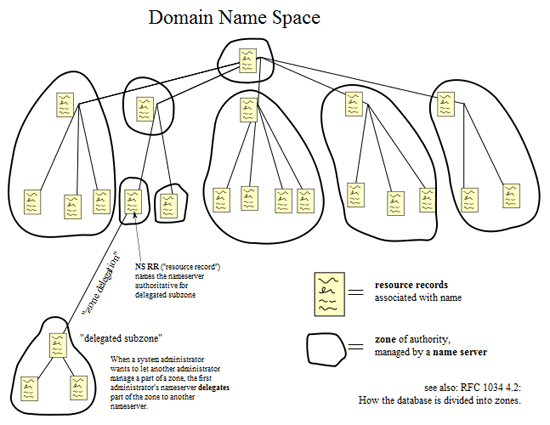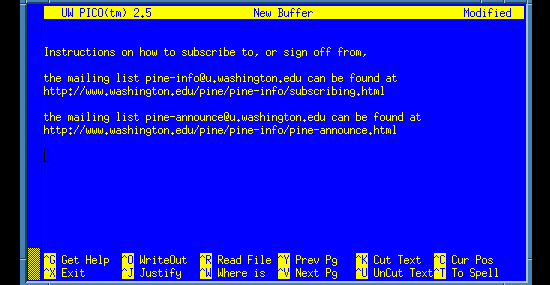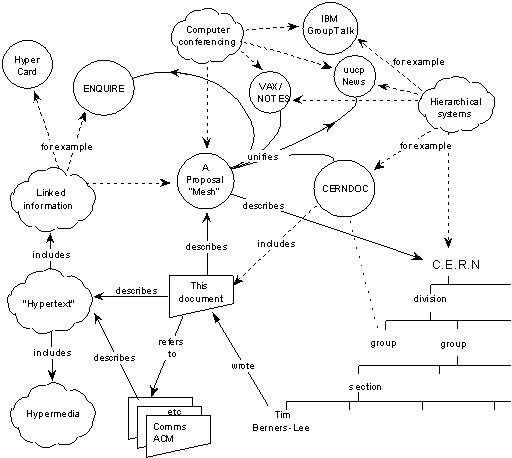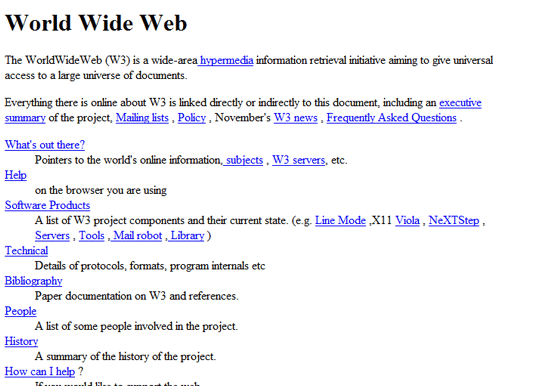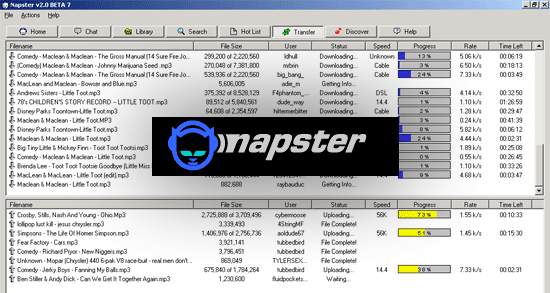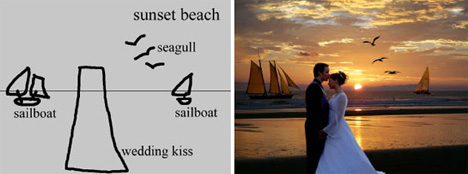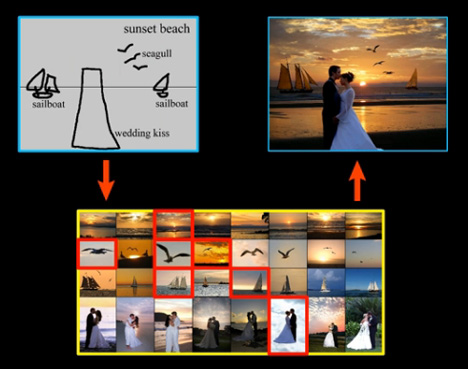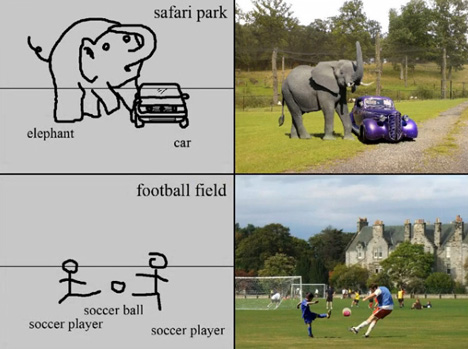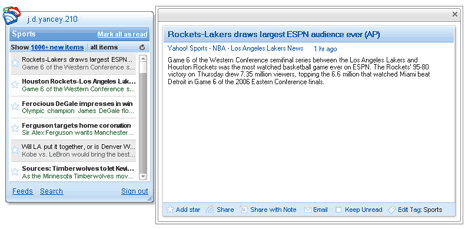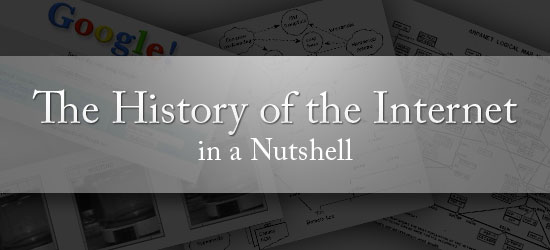
Here’s a brief history of the Internet, including important dates, people, projects, sites, and other information that should give you at least a partial picture of what this thing we call the Internet really is, and where it came from.
While the complete history of the Internet could easily fill a few books, this article should familiarize you with key milestones and events related to the growth and evolution of the Internet between 1969 to 2009.
1969: Arpanet
Arpanet was the first real network to run on packet switching technology (new at the time). On the October 29, 1969, computers at Stanford and UCLA connected for the first time. In effect, they were the first hosts on what would one day become the Internet.
The first message sent across the network was supposed to be "Login", but reportedly, the link between the two colleges crashed on the letter "g".
1969: Unix
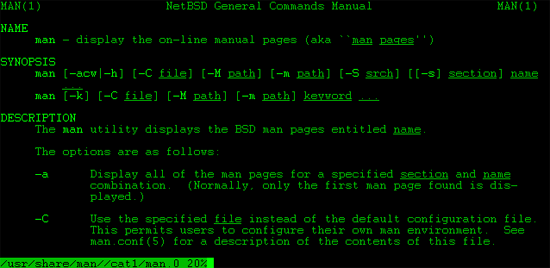
Another major milestone during the 60’s was the inception of Unix: the operating system whose design heavily influenced that of Linux and FreeBSD (the operating systems most popular in today’s web servers/web hosting services).
1970: Arpanet network
An Arpanet network was established between Harvard, MIT, and BBN (the company that created the "interface message processor" computers used to connect to the network) in 1970.
1971: Email

Email was first developed in 1971 by Ray Tomlinson, who also made the decision to use the "@" symbol to separate the user name from the computer name (which later on became the domain name).
1971: Project Gutenberg and eBooks
One of the most impressive developments of 1971 was the start of Project Gutenberg. Project Gutenberg, for those unfamiliar with the site, is a global effort to make books and documents in the public domain available electronically–for free–in a variety of eBook and electronic formats.
It began when Michael Hart gained access to a large block of computing time and came to the realization that the future of computers wasn’t in computing itself, but in the storage, retrieval and searching of information that, at the time, was only contained in libraries. He manually typed (no OCR at the time) the "Declaration of Independence" and launched Project Gutenberg to make information contained in books widely available in electronic form. In effect, this was the birth of the eBook.
1972: CYCLADES
France began its own Arpanet-like project in 1972, called CYCLADES. While Cyclades was eventually shut down, it did pioneer a key idea: the host computer should be responsible for data transmission rather than the network itself.
1973: The first trans-Atlantic connection and the popularity of emailing
Arpanet made its first trans-Atlantic connection in 1973, with the University College of London. During the same year, email accounted for 75% of all Arpanet network activity.
1974: The beginning of TCP/IP
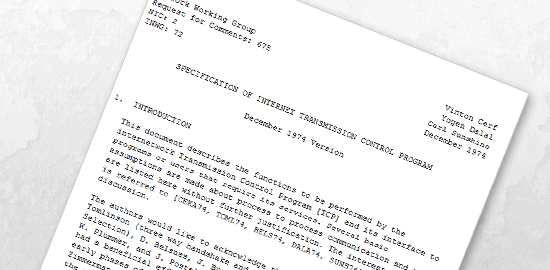
1974 was a breakthrough year. A proposal was published to link Arpa-like networks together into a so-called "inter-network", which would have no central control and would work around a transmission control protocol (which eventually became TCP/IP).
1975: The email client
With the popularity of emailing, the first modern email program was developed by John Vittal, a programmer at the University of Southern California in 1975. The biggest technological advance this program (called MSG) made was the addition of "Reply" and "Forward" functionality.
1977: The PC modem
1977 was a big year for the development of the Internet as we know it today. It’s the year the first PC modem, developed by Dennis Hayes and Dale Hetherington, was introduced and initially sold to computer hobbyists.
1978: The Bulletin Board System (BBS)
The first bulletin board system (BBS) was developed during a blizzard in Chicago in 1978.
1978: Spam is born
1978 is also the year that brought the first unsolicited commercial email message (later known as spam), sent out to 600 California Arpanet users by Gary Thuerk.
1979: MUD – The earliest form of multiplayer games
The precursor to World of Warcraft and Second Life was developed in 1979, and was called MUD (short for MultiUser Dungeon). MUDs were entirely text-based virtual worlds, combining elements of role-playing games, interactive, fiction, and online chat.
1979: Usenet
1979 also ushered into the scene: Usenet, created by two graduate students. Usenet was an internet-based discussion system, allowing people from around the globe to converse about the same topics by posting public messages categorized by newsgroups.
1980: ENQUIRE software
The European Organization for Nuclear Research (better known as CERN) launched ENQUIRE (written by Tim Berners-Lee), a hypertext program that allowed scientists at the particle physics lab to keep track of people, software, and projects using hypertext (hyperlinks).
1982: The first emoticon
![]()
While many people credit Kevin MacKenzie with the invention of the emoticon in 1979, it was Scott Fahlman in 1982 who proposed using :-) after a joke, rather than the original -) proposed by MacKenzie. The modern emoticon was born.
1983: Arpanet computers switch over to TCP/IP
January 1, 1983 was the deadline for Arpanet computers to switch over to the TCP/IP protocols developed by Vinton Cerf. A few hundred computers were affected by the switch. The name server was also developed in ‘83.
1984: Domain Name System (DNS)
The domain name system was created in 1984 along with the first Domain Name Servers (DNS). The domain name system was important in that it made addresses on the Internet more human-friendly compared to its numerical IP address counterparts. DNS servers allowed Internet users to type in an easy-to-remember domain name and then converted it to the IP address automatically.
1985: Virtual communities
1985 brought the development of The WELL (short for Whole Earth ‘Lectronic Link), one of the oldest virtual communities still in operation. It was developed by Stewart Brand and Larry Brilliant in February of ‘85. It started out as a community of the readers and writers of the Whole Earth Review and was an open but "remarkably literate and uninhibited intellectual gathering". Wired Magazine once called The Well "The most influential online community in the world."
1986: Protocol wars
The so-called Protocol wars began in 1986. European countries at that time were pursuing the Open Systems Interconnection (OSI), while the United States was using the Internet/Arpanet protocol, which eventually won out.
1987: The Internet grows
By 1987, there were nearly 30,000 hosts on the Internet. The original Arpanet protocol had been limited to 1,000 hosts, but the adoption of the TCP/IP standard made larger numbers of hosts possible.
1988: IRC – Internet Relay Chat
Also in 1988, Internet Relay Chat (IRC) was first deployed, paving the way for real-time chat and the instant messaging programs we use today.
1988: First major malicious internet-based attack
One of the first major Internet worms was released in 1988. Referred to as "The Morris Worm", it was written by Robert Tappan Morris and caused major interruptions across large parts of the Internet.
1989: AOL is launched
When Apple pulled out of the AppleLink program in 1989, the project was renamed and America Online was born. AOL, still in existence today, later on made the Internet popular amongst the average internet users.
1989: The proposal for the World Wide Web
1989 also brought about the proposal for the World Wide Web, written by Tim Berners-Lee. It was originally published in the March issue of MacWorld, and then redistributed in May 1990. It was written to persuade CERN that a global hypertext system was in CERN’s best interest. It was originally called "Mesh"; the term "World Wide Web" was coined while Berners-Lee was writing the code in 1990.
1990: First commercial dial-up ISP
1990 also brought about the first commercial dial-up Internet provider, The World. The same year, Arpanet ceased to exist.
1990: World Wide Web protocols finished
The code for the World Wide Web was written by Tim Berners-Lee, based on his proposal from the year before, along with the standards for HTML, HTTP, and URLs.
1991: First web page created
1991 brought some major innovations to the world of the Internet. The first web page was created and, much like the first email explained what email was, its purpose was to explain what the World Wide Web was.
1991: First content-based search engine
Also in the same year, the first search engine that examined file contents instead of just file names was launched, called Gopher.
1991: MP3 becomes a standard
Also, the MP3 file format was accepted as a standard in 1991. MP3 files, being highly compressed, later become a popular file format to share songs and entire albums via the internet.
1991: The first webcam
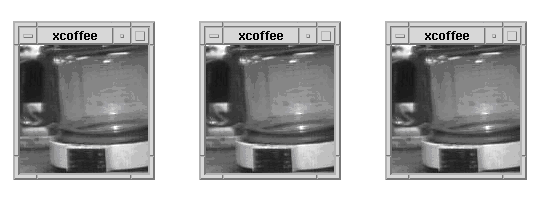
One of the more interesting developments of this era, though, was the first webcam. It was deployed at a Cambridge University computer lab, and its sole purpose was to monitor a particular coffee maker so that lab users could avoid wasted trips to an empty coffee pot.
1993: Mosaic – first graphical web browser for the general public
The first widely downloaded Internet browser, Mosaic, was released in 1993. While Mosaic wasn’t the first web browser, it is considered the first browser to make the Internet easily accessible to non-techies.
1993: Governments join in on the fun
In 1993, both the White House and the United Nations came online, marking the beginning of the .gov and .org domain names.
1994: Netscape Navigator
Mosaic’s first big competitor, Netscape Navigator, was released the year following (1994).
1995: Commercialization of the internet
1995 is often considered the first year the web became commercialized. While there were commercial enterprises online prior to ‘95, there were a few key developments that happened that year. First, SSL (Secure Sockets Layer) encryption was developed by Netscape, making it safer to conduct financial transactions (like credit card payments) online.
In addition, two major online businesses got their start the same year. The first sale on "Echo Bay" was made that year. Echo Bay later became eBay. Amazon.com also started in 1995, though it didn’t turn a profit for six years, until 2001.
1995: Geocities, the Vatican goes online, and JavaScript
Other major developments that year included the launch of Geocities (which officially closed down on October 26, 2009).
The Vatican also went online for the first time.
Sun Microsystems launched the Java and JavaScript programming languages in 1995. ActiveX was launched by Microsoft the following year.
1996: First web-based (webmail) service
In 1996, HoTMaiL (the capitalized letters are an homage to HTML), the first webmail service, was launched.
1997: The term "weblog" is coined
While the first blogs had been around for a few years in one form or another, 1997 was the first year the term "weblog" was used.
1998: First new story to be broken online instead of traditional media
In 1998, the first major news story to be broken online was the Bill Clinton/Monica Lewinsky scandal (also referred to as "Monicagate" among other nicknames), which was posted on The Drudge Report after Newsweek killed the story.
1998: Google!
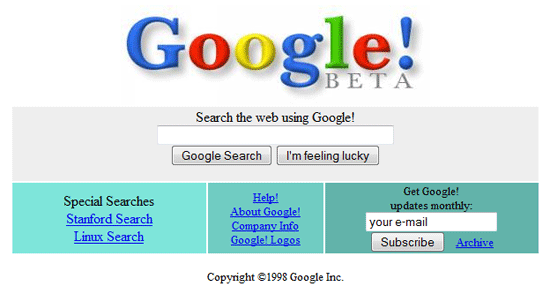
Google went live in 1998, revolutionizing the way in which people find information online.
1998: Internet-based file-sharing gets its roots
In 1998 as well, Napster launched, opening up the gates to mainstream file-sharing of audio files over the internet.
1999: SETI@home project
1999 is the year when one of the more interesting projects ever brought online: the SETI@home project, launched. The project has created the equivalent of a giant supercomputer by harnessing the computing power of more than 3 million computers worldwide, using their processors whenever the screensaver comes on, indicating that the computer is idle. The program analyzes radio telescope data to look for signs of extraterrestrial intelligence.
2000: The bubble bursts
2000 was the year of the dotcom collapse, resulting in huge losses for legions of investors. Hundreds of companies closed, some of which had never turned a profit for their investors. The NASDAQ, which listed a large number of tech companies affected by the bubble, peaked at over 5,000, then lost 10% of its value in a single day, and finally hit bottom in October of 2002.
2001: Wikipedia is launched
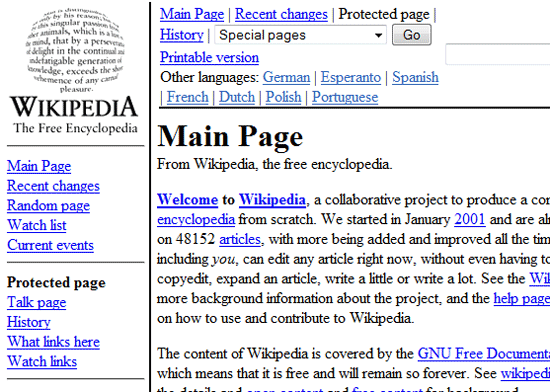
With the dotcom collapse still going strong, Wikipedia launched in 2001, one of the websites that paved the way for collective web content generation/social media.
2003: VoIP goes mainstream
In 2003: Skype is released to the public, giving a user-friendly interface to Voice over IP calling.
2003: MySpace becomes the most popular social network
Also in 2003, MySpace opens up its doors. It later grew to be the most popular social network at one time (thought it has since been overtaken by Facebook).
2003: CAN-SPAM Act puts a lid on unsolicited emails
Another major advance in 2003 was the signing of the Controlling the Assault of Non-Solicited Pornography and Marketing Act of 2003, better known as the CAN-SPAM Act.
2004: Web 2.0
Though coined in 1999 by Darcy DiNucci, the term "Web 2.0", referring to websites and Rich Internet Applications (RIA) that are highly interactive and user-driven became popular around 2004. During the first Web 2.0 conference, John Batelle and Tim O’Reilly described the concept of "the Web as a Platform": software applications built to take advantage of internet connectivity, moving away from the desktop (which has downsides such as operating system dependency and lack of interoperability).
2004: Social Media and Digg
The term "social media", believed to be first used by Chris Sharpley, was coined in the same year that "Web 2.0" became a mainstream concept. Social media–sites and web applications that allow its users to create and share content and to connect with one another–started around this period.
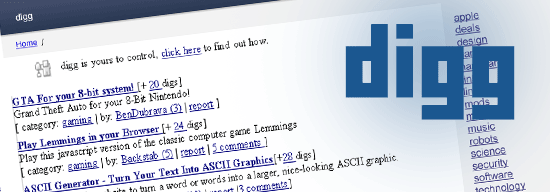
Digg, a social news site, launched on November of 2004, paving the way for sites such as Reddit, Mixx, and Yahoo! Buzz. Digg revolutionized traditional means of generating and finding web content, democratically promoting news and web links that are reviewed and voted on by a community.
2004: "The" Facebook open to college students

Facebook launched in 2004, though at the time it was only open to college students and was called "The Facebook"; later on, "The" was dropped from the name, though the URL http://www.thefacebook.com still works.
2005: YouTube – streaming video for the masses
YouTube launched in 2005, bringing free online video hosting and sharing to the masses.
2006: Twitter gets twittering
Twitter launched in 2006. It was originally going to be called twittr (inspired by Flickr); the first Twitter message was "just setting up my twttr".
2007: Major move to place TV shows online
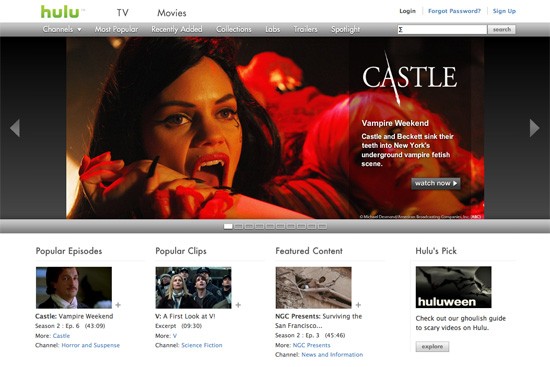
Hulu was first launched in 2007, a joint venture between ABC, NBC, and Fox to make popular TV shows available to watch online.
2007: The iPhone and the Mobile Web
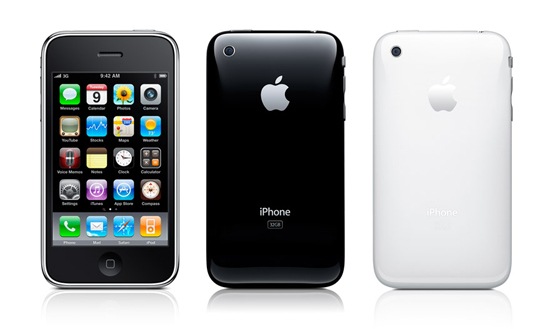
The biggest innovation of 2007 was almost certainly the iPhone, which was almost wholly responsible for renewed interest in mobile web applications and design.
2008: "Internet Election"
The first "Internet election" took place in 2008 with the U.S. Presidential election. It was the first year that national candidates took full advantage of all the Internet had to offer. Hillary Clinton jumped on board early with YouTube campaign videos. Virtually every candidate had a Facebook page or a Twitter feed, or both.
Ron Paul set a new fundraising record by raising $4.3 million in a single day through online donations, and then beat his own record only weeks later by raising $4.4 million in a single day.
The 2008 elections placed the Internet squarely at the forefront of politics and campaigning, a trend that is unlikely to change any time in the near future.
[VIA SixRevisions]
